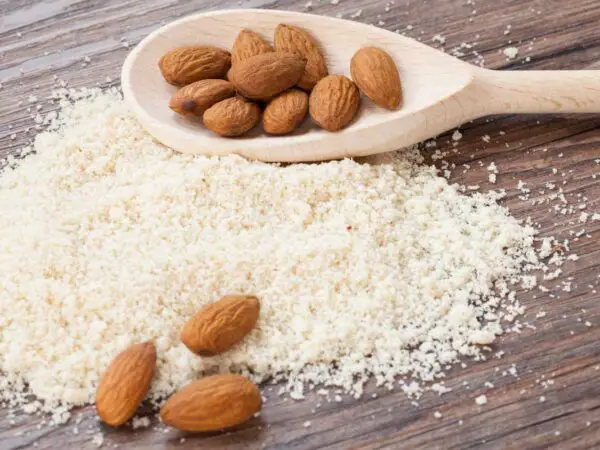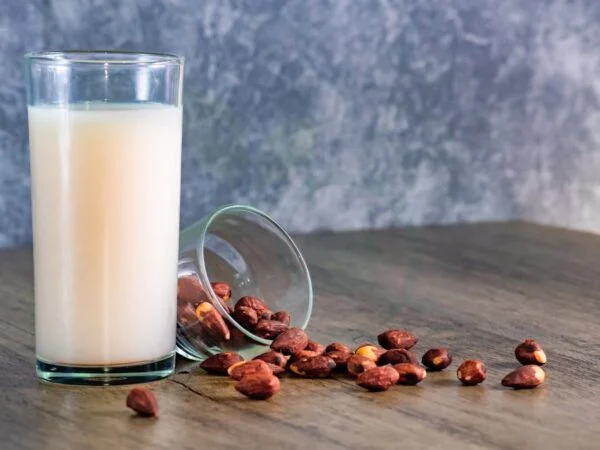Ever wondered how much milk can be derived from 1 pound of almonds? The process of making almond milk is not only intriguing but also a hot topic among health-conscious individuals. In this post, we'll delve into the fascinating world of almond milk production and uncover the answer to that burning question. From understanding the almond-to-milk conversion ratio to exploring the environmental impact and almonds use, we've got you covered.
Stay tuned as we unravel the mystery behind this popular dairy alternative and provide insights into its nutritional value and versatility in various recipes. Get ready to discover everything you need to know about turning humble almonds into a creamy, plant-based beverage that has taken the culinary world by storm.
Key Takeaways
-
Making almond milk at home is a cost-effective and environmentally friendly alternative to store-bought options.
-
Using 1 pound of almonds can yield approximately 5-6 cups of almond milk, providing much for your needs.
-
Pay attention to the texture and quality of your homemade almond milk by adjusting the water-to-almond ratio to achieve the desired consistency.
-
To enhance the shelf life and freshness of homemade almond milk, store it in a sealed container in the refrigerator and consume within 3-4 days.
-
Enjoy the health benefits of almond milk, such as being dairy-free, low in calories, and rich in nutrients like vitamin E and calcium.
-
Consider the cost savings and reduced environmental impact of making your own almond milk, while also having control over the ingredients and flavor.
Almond Milk Essentials
Almond to Water Ratio
When making almond milk, the ideal almond to water ratio is 1:4. This means that for every pound of almonds, you would use four pounds of water. However, this ratio can be adjusted based on your desired creaminess and consistency. If you prefer a richer texture, you can increase the amount of almonds or decrease the water content. On the other hand, if you want a lighter consistency, then increasing the amount of water might be more suitable. It's essential to experiment with different ratios to find what suits your taste preferences best.
For instance:
-
A thicker almond milk may require a higher proportion of almonds.
-
If you prefer a lighter texture, adjusting the ratio by adding more water could be beneficial.
Nutritional Profile
Almond milk boasts an impressive nutritional profile as it is rich in vitamin E, calcium, and healthy fats. Moreover, it is low in calories and contains no cholesterol or saturated fat. The presence of antioxidants also makes almond milk a valuable addition to one's diet as it contributes to overall well-being.
Consider these points:
-
Vitamin E in almond milk promotes healthy skin and acts as an antioxidant.
-
The absence of cholesterol makes almond milk heart-friendly.
Required Ingredients
To make almond milk, only two ingredients are necessary: almonds and water. It's crucial that the almonds used are raw and unsalted for optimal results when preparing this dairy-free alternative at home. While these are the basic ingredients required for making almond milk from scratch, optional additions such as sweeteners or flavorings can be incorporated according to personal preference.
Remember:
-
Raw and unsalted almonds ensure pure flavor without any unwanted additives.
-
Optional sweeteners like dates or honey can enhance the taste according to individual liking.
Making Almond Milk at Home
Making almond milk at home involves a simple process of blending soaked almonds with water and then extracting the liquid. Straining is a crucial step in this process to achieve smooth, creamy almond milk.
Straining Methods
To extract the liquid from the blended almonds, you can use various straining methods such as a nut milk bag, cheesecloth, or fine-mesh sieve. These tools help separate the almond pulp from the liquid, resulting in smooth and pulp-free almond milk. Once you pour the blended mixture into any of these strainers, gently squeeze or press it to release all the liquid while leaving behind the pulp.
Using a nut milk bag is particularly effective for this purpose because it allows easy squeezing without letting any solid particles pass through. If necessary, you can repeat this straining process to ensure an even smoother consistency for your almond milk.
Pulp Utilization
The leftover almond pulp after straining isn't waste; instead, it can be repurposed for other culinary creations. You can incorporate it into recipes like smoothies, baked goods such as cookies or muffins, or granola bars to add texture and flavor. Dehydrating the pulp provides an opportunity to create gluten-free almond flour that can be used in various baking recipes.
Quantity Yield from Almonds
Milk from One Pound
On average, 1 pound of almonds yields approximately 5–6 cups of almond milk. The exact amount may vary based on factors such as soaking time and blending efficiency. For instance, if you soak the almonds for a longer period, they tend to yield more milk when blended. Conversely, inadequate soaking might result in a lower yield. The thoroughness of the blending process plays a crucial role in extracting maximum liquid from the almonds.
It's essential to adjust quantities based on individual consumption needs. If you frequently use almond milk in various recipes or consume it daily, accounting for these factors becomes even more important. Understanding how much milk one can obtain from a specific quantity of almonds enables better planning and ensures that there's always an adequate supply without excessive waste.
Factors Affecting Yield
The freshness and quality of almonds significantly impact the yield of almond milk. Freshly purchased or harvested almonds are likely to produce higher yields compared to older ones that have been stored for an extended period. Proper soaking techniques also influence the extraction process; ensuring that almonds are adequately soaked softens them and facilitates easier blending.
Moreover, employing efficient blending methods is crucial for maximizing liquid extraction during the preparation of almond milk at home. Adjustments in straining methods may also affect the final yield - using finer mesh strainers can help capture more fine particles resulting in increased overall output.
Texture and Quality
The key is to use a higher proportion of almonds to water. By increasing the amount of almonds used, you can create a richer and creamier texture in your almond milk. Adding a small amount of vanilla extract or dates can enhance both the creaminess and flavor of the almond milk. Experimenting with different blending times and techniques allows you to customize the texture according to your preference.
Comparing homemade almond milk with store-bought varieties reveals that homemade almond milk offers a fresher taste due to its lack of additives, preservatives, and stabilizers commonly found in many store-bought versions. When making your own almond milk, you have full control over the ingredients used, allowing for customization based on personal preferences. This level of control ensures that your homemade almond milk remains free from any unwanted or unnecessary additives.
Usage Tips for Homemade Almond Milk
Storage Practices
Homemade almond milk can be stored in a sealed container in the refrigerator for up to 4–5 days. It's important to shake well before each use because natural separation may occur over time. To maintain its freshness, it's best to avoid prolonged exposure to air and light.
When storing homemade almond milk, using an airtight container helps prevent it from absorbing other odors or flavors present in the fridge. Shaking the almond milk before use ensures that any settled particles are evenly distributed throughout the liquid. This practice is crucial as natural separation occurs due to the absence of additives or stabilizers commonly found in store-bought almond milk.
Recipe Applications
Homemade almond milk is incredibly versatile and can be used in various ways. It can be added to coffee, tea, smoothies, oatmeal, or cereal as a dairy alternative. The creamy texture of almond milk makes it ideal for incorporating into recipes such as pancakes, muffins, sauces, or soups.
Using homemade almond milk instead of dairy products not only adds a nutty flavor but also provides essential nutrients without lactose or cholesterol content. Its subtle taste allows it to complement both sweet and savory dishes equally well—making it suitable for experimenting with different culinary creations.
Cost Considerations
Homemade vs. Store-Bought
The amount of money you can save compared to purchasing store-bought alternatives is quite significant. By using raw almonds and water as the base ingredients for homemade almond milk, you can cut down on costs considerably. When preparing almond milk at home, you have the freedom to tailor it according to your preferences by adjusting sweetness and flavorings.
For example, if you prefer your almond milk less sweet or with a hint of vanilla flavor, these adjustments are easily achievable when making it yourself. This level of customization not only saves money but also ensures that each batch meets your specific taste preferences without having to spend a lot of money on specialized products.
Health Benefits
Nutritional Advantages
Homemade almond milk offers several nutritional benefits over store-bought options. When making your own almond milk, you have control over the sugar content, eliminating the need for added sweeteners or excessive sugars often found in commercial brands. By using whole almonds, you can enjoy the natural nutritional advantages without any added thickeners or emulsifiers that are commonly found in processed almond milk. This means that you get all the goodness of almonds without any unnecessary additives.
When preparing homemade almond milk, you have the flexibility to personalize fortification options based on your dietary needs. For example, if you require more calcium or vitamin D in your diet, you can easily adjust and fortify your homemade almond milk accordingly. This level of personalization is not typically available with store-bought varieties and allows for a more tailored approach to meeting specific nutritional requirements.
Allergy-Friendly Option
Almond milk serves as an excellent dairy-free alternative for individuals with lactose intolerance or dairy allergies. Its plant-based nature makes it suitable for those following vegan or vegetarian diets as well. The absence of animal products ensures that it's a great option for people with various dietary restrictions.
However, it's important to be mindful of cross-contamination risks when preparing almond milk in shared kitchen spaces where other allergens might be present. If someone has a severe nut allergy within the household or shared environment, extra precautions should be taken to prevent any accidental exposure.
Environmental Considerations
Water Usage Impact
Compared to dairy production, making almond milk consumes significantly less water. Almonds require a substantial amount of water to grow, but the overall water footprint of almond milk is still lower than that of cow's milk. Mindful water usage during soaking and rinsing processes contributes to sustainability efforts. For instance, reusing the water used for soaking almonds in other household activities can help reduce wastage.
When producing almond milk at home, it's essential to be aware of the impact of water usage. By using efficient methods when soaking and rinsing almonds, you can minimize your contribution to excessive water consumption. This conscious approach aligns with sustainable practices and helps conserve this vital resource.
Sustainable Practices
To promote sustainable practices while making almond milk, there are several steps you can take. One way is to utilize leftover almond pulp creatively instead of discarding it as waste. The pulp can be repurposed in various recipes such as smoothies, baked goods, or even as a base for homemade granola bars.
Choosing organic almonds when possible also supports sustainable farming practices by encouraging environmentally friendly cultivation methods that avoid synthetic pesticides and fertilizers. Opting for reusable nut milk bags or cheesecloth instead of single-use straining materials reduces unnecessary waste generation associated with the preparation process.
Shelf Life and Freshness
Preservation Techniques
Freezing excess in ice cube trays is a great way to ensure that none of it goes to waste. By doing this, you can conveniently use the almond milk cubes for beverages or cooking at a later time. Labeling containers with preparation dates is also crucial for tracking freshness and ensuring timely consumption. Creating flavored variations and freezing them into popsicles can extend the shelf life of your almond milk through preservation methods.
For instance, if you make extra almond milk but don't plan on using it right away, pouring it into ice cube trays and placing them in the freezer allows you to have readily available portions for smoothies or recipes without worrying about spoilage. Moreover, adding natural flavorings like vanilla or cocoa before freezing can enhance the taste and prolong its usability.
Signs of Spoilage
It's important to be able to identify signs of spoilage in almond milk. If your almond milk develops an off odor, unusual coloration, or undesirable taste, it's best to discard it immediately as these are clear indicators of spoilage. Furthermore, separation beyond normal settling may also indicate spoilage; therefore shaking well before assessing quality is recommended.
To minimize risks of contamination and spoilage throughout the preparation and storage processes:
-
Ensure proper hygiene during every step.
-
Use clean equipment when making almond milk.
-
Store the finished product in sanitized containers.
-
Refrigerate promptly after preparing.
Final Remarks
Congratulations on mastering the art of making your own almond milk! You've learned about the quantity yield from almonds, the texture and quality of homemade almond milk, cost considerations, health benefits, environmental impact, and shelf life. Now, armed with this knowledge, you can confidently whip up your creamy, nutty concoction whenever you please. Whether you're a dedicated home chef or simply someone who enjoys experimenting in the kitchen, making almond milk at home is an enriching experience that allows you to customize your drink to perfection. So go ahead, grab a pound of almonds and start squeezing out that liquid gold!
Frequently Asked Questions
How much almond milk does 1 pound of almonds make?
On average, 1 pound of almonds yields approximately 5-6 cups of almond milk. However, the exact quantity can vary based on factors such as the soaking and blending process. It's a bit like how different chefs might get slightly different results from the same recipe.
Is homemade almond milk better than store-bought?
Homemade almond milk tends to be fresher and free from additives or preservatives commonly found in store-bought versions. Plus, you have control over the ingredients and can customize flavors to your liking. It's like comparing a tailor-made suit to an off-the-rack one - there's a noticeable difference.
How long does homemade almond milk last?
When stored properly in the refrigerator, homemade almond milk typically stays fresh for about 3-4 days. This shorter shelf life compared to commercial varieties is due to its lack of preservatives. Think of it as similar to fresh produce – it’s best enjoyed within a few days.
What are some cost considerations when making almond milk at home?
While initial costs may seem higher due to purchasing almonds and equipment, over time, making your own almond milk can be more economical than buying pre-made options regularly. It's akin to investing upfront in quality tools that pay off with savings down the road.
Are there any health benefits associated with consuming almond milk?
Almond milk is rich in nutrients like vitamin E and calcium while being lower in calories than cow’s milk. It is naturally lactose-free and suitable for those with dairy allergies or intolerances.
Image Source: Paid image from CANVA




